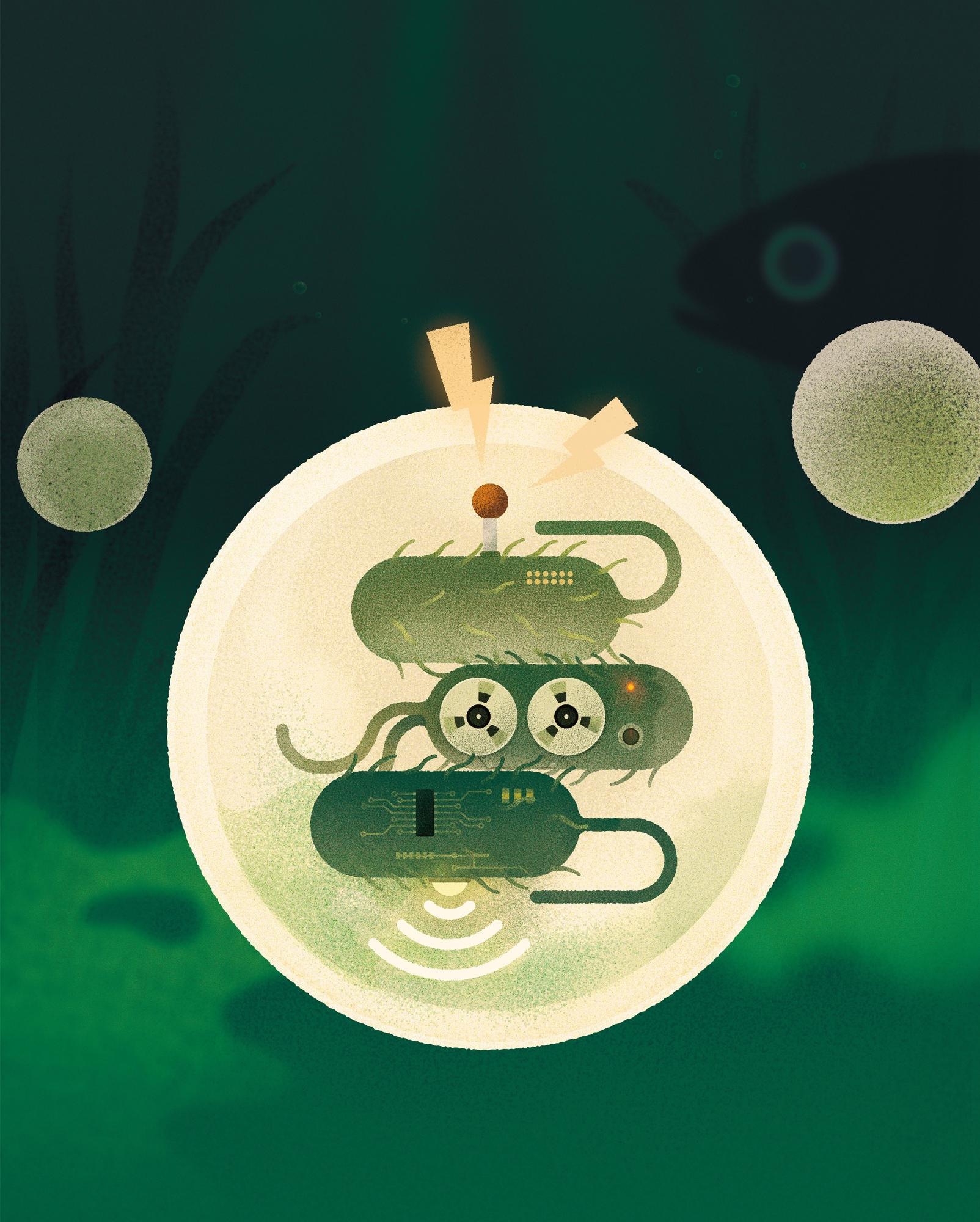The Synthetic Biology Group (led by Professor Timothy Lu) at MIT works on basic genetic tool development and translational researches for medical and environmental applications, nearly all aspects of synthetic biology. This exciting new field uses engineering principles to design and optimize biological systems, making them perform tasks in ways we want them to.
Reprogramming cells is very much like programming on computers, but instead, you run codes written in DNA and build genetic circuits that dictate organisms' behaviors. For example, in our newest project, we built engineered bacteria that can respond to various contaminants in the environment and at the same time record them and perform simple computations. We trapped them in hydrogel shells so that they can not escape but still have access to the nutrients and chemical inputs present in the environment. We called it the DEployable Physical COntainment Strategy (DEPCOS) that allows safe deployment of smart biosensors for environmental monitoring in the real world.

Tough hydrogel and genetic devices provide near-perfect biocontainment of bacteria for continuous sensing and computation in the real world.Image Credit: Chenfu Hsing
Aside from your team's project, what are some of the other uses of hydrogel shells?
Our collaborator, Professor Xuanhe Zhao's group at MIT, developed the tough hydrogel used in DEPCOS. In addition to making deployable beads, we previously showed that combining hydrogel and programmable cells can generate several living devices, such as skin patches or tattoos that can sense and respond to chemicals with color change. Biocompatible hydrogels offer a great platform for developing soft but yet tough wearables hosting living cells.
What environmental contaminants could the bacteria detect?
The engineered bacteria we used in the DEPCOS project can sense small molecules such as sugars, antibiotics, blood, and metal ions in water. A big community of synthetic biologists worldwide is developing biosensors to detect a wide spectrum of chemical contaminants such as toxins and explosives. We hope that our hydrogel technologies could be a packaging platform compatible with their biosensors and help bring their inventions to real applications.
What are some of the common problems associated with the use of whole-cell biosensors?
The biggest issue is, of course, about safety. How can we use these whole-cell biosensors while keeping them in check? It is extremely difficult to estimate the damage escaped genetic materials can bring to us in the long term. Hopefully, our DEPCOS platform provides a possible solution by combining chemical and physical containment strategies, making the whole-cell biosensors hard to escape and survive in the wild.
For some time, researchers have engineered genetic traits in bacteria that they usually don't possess. How has this been done, and what are the benefits of doing this?
You can probably find microbes everywhere in this world. No matter where they are, they need to respond to the surrounding environment using different built-in sensors. Synthetic biologists search and port these parts of interest into chassis microbes that we know how to engineer very well and link these sensors to some standard reporters. For example, we often use E. coli as a chassis, bring in a sensor from another species, and wire it up to a green fluorescent protein output that is easy to visualize.
What are some of the benefits of hydrogel shielding for bacteria sensors?
Hydrogels are great for encasing biosensors because they are basically "solid water," allowing free diffusion of liquids and small molecules. Bacteria sensors require dissolved nutrients to survive and easy access to the analytes they are detecting. However, most hydrogels are not very resistant to physical damages and break quite easily. To build a shield that prevents cells from escaping under physical challenges, you need a tough hydrogel with good mechanical properties and thus difficult to break.
How were the hydrogel spheres made?
We first mixed the bacteria biosensors with alginate, a hydrogel from brown seaweed, and turned them into spherical cores. Then, we coated these spheres with the tough hydrogel solution and chemical crosslinkers. You can get a thicker, more robust shell if you repeat this process a few times. These beads were then soaked in growth media and ready for deployment. You may store them in a refrigerator as they can stay viable for a few weeks at low temperatures.
How was the deployable physical containment strategy (DEPCOS) system tested?
We challenged the DEPCOS beads in many different ways, both chemically and physically. We tested them in an acidic environment, with antibiotics treatment, and under repeated mechanical pressing. The system protected the encased cells from harsh environmental conditions and also prevented their escape. We also put them in real river water, in a beaker in the lab, and found they could perform their sensing tasks well. We wanted to test them in the real river, but unfortunately, current regulations prevent us from doing so.
What are some of the future applications of the DEPCOS system?
The DEPCOS platform is quite versatile in terms of geometries and the cell types it can encase. In our published study, we showed that blood-sensing biosensors functioned quite well inside the hydrogel beads. Along this direction, a future application could be sending ingestible DEPCOS beads into a patient's gut to detect bleeding or other disease-related biomarkers.
If we could better engineer the hydrogel, we might achieve controlled drug release from engineered microbes and even mammalian cells one day. As for environmental applications, the DEPCOS beads encasing biosensors with recording capabilities would be valuable for cheap water quality monitoring because they require minimum energy input and no electronics.
What's next for the team at MIT?
We are constantly optimizing the systems we developed in the past. For example, we are trying to see if we could reduce the response time of our bacteria sensors. The current standard is around 30 minutes, which is not fast enough to capture transient changes in analyte concentration. In another direction, we are looking into producing living materials that do not require artificial scaffolds. The DEPCOS system has exceptional properties, but the beads can not replicate themselves as they need us to manufacture the hydrogels.
Inspired by the kombucha mother, we recently developed a microbial co-culture system that can grow smart filters that can detect and remove contaminants in water. All you need are tea, sugar, a piece of an engineered kombucha mother, and 2-3 days. Systems like this could be useful in resource-limited areas where you do not have access to trained experts and equipment.
Where can readers find more information?
Details about the DEPCOS system can be found in this paper. For readers interested in the kombucha materials I mentioned earlier, here is a direct link to the paper. The Synthetic Biology Group at MIT recently published a summary on the current state of using synthetic biology to develop functional materials that can be found here.
About Tzu-Chieh (Zijay) Tang
 Tzu-Chieh (Zijay) Tang recently received his Ph.D. from the Department of Biological Engineering at MIT, where he worked with both the Synthetic Biology Group at Research Laboratory of Electronics (RLE) and the Mediated Matter group at MIT Media Lab. With a strong interest in Nature's design, he is currently working on combing synthetic biology and materials design into the development of living functional materials that sense and respond to the environment. He is also the inaugural J-WAFS fellow at MIT and the winner of the 2020 Lemelson-MIT Student Prize.
Tzu-Chieh (Zijay) Tang recently received his Ph.D. from the Department of Biological Engineering at MIT, where he worked with both the Synthetic Biology Group at Research Laboratory of Electronics (RLE) and the Mediated Matter group at MIT Media Lab. With a strong interest in Nature's design, he is currently working on combing synthetic biology and materials design into the development of living functional materials that sense and respond to the environment. He is also the inaugural J-WAFS fellow at MIT and the winner of the 2020 Lemelson-MIT Student Prize.
Disclaimer: The views expressed here are those of the interviewee and do not necessarily represent the views of AZoM.com Limited (T/A) AZoNetwork, the owner and operator of this website. This disclaimer forms part of the Terms and Conditions of use of this website.